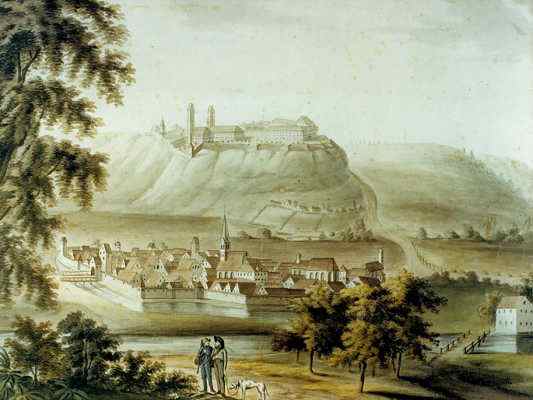
History
of the city of Beilngries in the national park Altmuehl valley
The lower Altmuehl valley is one of the oldest European areas of settlement, with traces of man dating back to the Old Stone Age.
The oldest document with the name Beilngries was written A.D. 1007. The name Beilngries is derived from the forename "Biling" and the old word Gries (now obsolete) which means "sand and gravel at the riverside". The coat of arms shows two crossed battle-axes; it has been used in the seal of the council since 1406.
In 1053 the settlement was given the right to hold markets and to collect tolls. At that time Beilngries was under the rule of Bishop Gebhardt of Eichstaett who had been steward of the household of the Roman Emperor Henry III. The Emperor even granted the right of penal judicature.
The centre of the medieval settlement must have been near the parish church of St. Walpurgis ![]() the northern tower of which is the oldest building of Beilngries.
the northern tower of which is the oldest building of Beilngries.
In the later Middle Ages trade and craft in Beilngries were thriving. The burghers constructed a public water-supply system which was maintained by water rates and rentals of the municipal fish troughs.
The rulers of Beilngries, the bishops of Eichstaett, were princes of the Holy Roman Empire, and as ecclesiastical princes they did not spend too much money for their princely household and, above all, they did not interfere in all the quarrels and feuds of the time. Living under crosier was relatively comfortable.
Nevertheless, Beilngries was affected by the troubles and woes of war. In the Peasants´ War, the fortifications of Beilngries proved to be strong enough to keep off the attackers. The Abbey of Plankstetten ![]() , a short distance away, was ransacked and demolished by revolting peasants.
, a short distance away, was ransacked and demolished by revolting peasants.
In the Thirty Years´ War, Beilngries was successfully defended against an attack of 300 Swedish horsemen. When some weeks later the Swedish Commander-in-chief appeared, Beilngries was surrendered to the enemy without fighting. Thanks to clever negotiations, ravaging and contribution could be avoided. Beilngries is still in possession of the safeconduct of the Swedish commander who forbade looting and any act of violence.
When the long and dreadful war ended in 1648, Beilngries was, though undestroyed, totally exhausted. lt lasted almost half a century until peasants and craftsmen, trade and commerce had recovered.
Until the end of the 18th century Beilngries was spared disasters of war. But the Wars of the French Revolution triggered hardships and sufferings. Some companies of the French army occupied the town for several weeks, and people had to pay for all costs. The amount of 900 florins does not seem devastating, but it was as much as the town treasurer collected in taxes a whole year.
In 1802 the Government of the Electorate of Bavaria ordered the occupation of Eichstaett ![]() because they wanted to annex the princedom, as a recompense for lost territory in the Rhine Palatinate. But Eichstaett was given to Salzburg, and it was not before 1805 that the land was made part of Bavaria, now kingdom. The troubles of war again impoverished people.
because they wanted to annex the princedom, as a recompense for lost territory in the Rhine Palatinate. But Eichstaett was given to Salzburg, and it was not before 1805 that the land was made part of Bavaria, now kingdom. The troubles of war again impoverished people.
Prosperity came with the building of the Ludwig-Danube-Main-Canal and the railway construction (the line to Neumarkt). When the boundaries of the Bavarian districts were redrawn, the district of Beilngries ceased to function as official area (in 1972) and became part of the district of Eichstaett.
back to the Homepage of the town Beilngries ![]()
Zuletzt aktualisiert am 10.02.2017